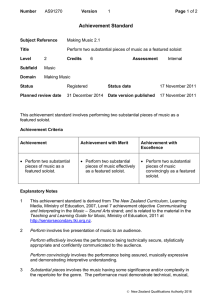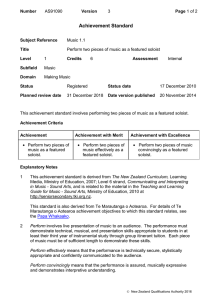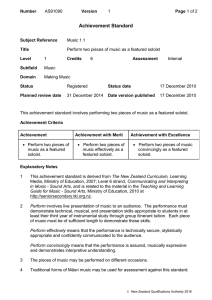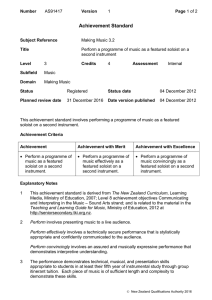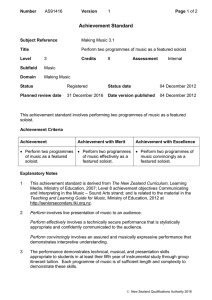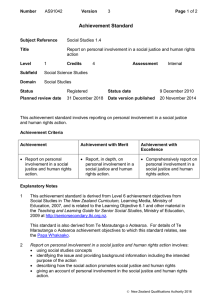Achievement Standard
advertisement
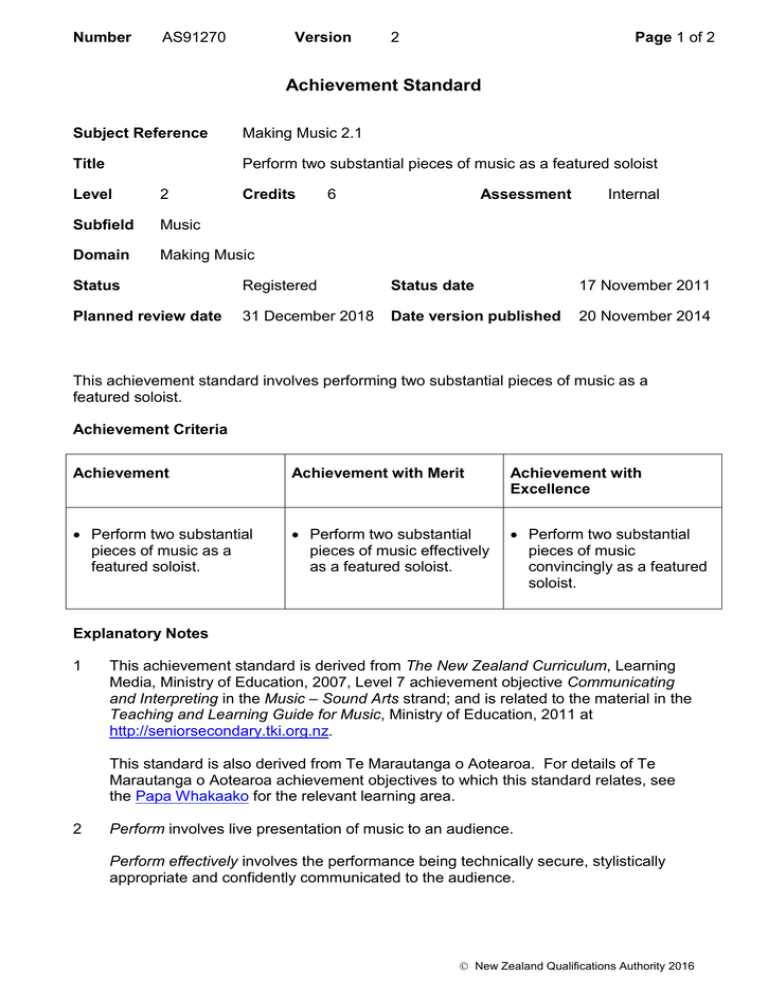
Number AS91270 Version 2 Page 1 of 2 Achievement Standard Subject Reference Making Music 2.1 Title Perform two substantial pieces of music as a featured soloist Level 2 Credits Subfield Music Domain Making Music 6 Assessment Internal Status Registered Status date 17 November 2011 Planned review date 31 December 2018 Date version published 20 November 2014 This achievement standard involves performing two substantial pieces of music as a featured soloist. Achievement Criteria Achievement Achievement with Merit Achievement with Excellence Perform two substantial pieces of music as a featured soloist. Perform two substantial pieces of music effectively as a featured soloist. Perform two substantial pieces of music convincingly as a featured soloist. Explanatory Notes 1 This achievement standard is derived from The New Zealand Curriculum, Learning Media, Ministry of Education, 2007, Level 7 achievement objective Communicating and Interpreting in the Music – Sound Arts strand; and is related to the material in the Teaching and Learning Guide for Music, Ministry of Education, 2011 at http://seniorsecondary.tki.org.nz. This standard is also derived from Te Marautanga o Aotearoa. For details of Te Marautanga o Aotearoa achievement objectives to which this standard relates, see the Papa Whakaako for the relevant learning area. 2 Perform involves live presentation of music to an audience. Perform effectively involves the performance being technically secure, stylistically appropriate and confidently communicated to the audience. New Zealand Qualifications Authority 2016 Number AS91270 Version 2 Page 2 of 2 Perform convincingly involves the performance being assured, musically expressive and demonstrating interpretive understanding. 3 Substantial pieces involves the music having some significance and/or complexity in the repertoire for the genre. The performance must demonstrate technical, musical, and presentation skills appropriate to students in at least their fourth year of instrumental study and/or through group itinerant tuition. Each piece of music must be of sufficient length to demonstrate these skills. 4 The two pieces of music may be performed on different occasions. 5 Traditional and contemporary forms of Māori music may be used for assessment against this standard. 6 Improvisation can be used as evidence to meet the requirements of this standard. 7 Featured soloist may be unaccompanied or accompanied, or a featured soloist in a small group. The featured soloist must be easily heard and seen, and must play a separate or uniquely identifiable part. 8 The performance of each piece of music must be assessed holistically to provide an overall judgement based on the weight of evidence across both performances. This means considering the musicality and merits of the whole performance, rather than placing emphasis on small technical inaccuracies or minor slip-ups. 9 The assessment criteria must be applied to provide an overall judgement based on the weight of evidence across both performances. 10 Conditions of Assessment related to this achievement standard can be found at http://ncea.tki.org.nz/Resources-for-Internally-Assessed-Achievement-Standards. Replacement Information This achievement standard replaced AS90264 and unit standard 10652. Quality Assurance 1 Providers and Industry Training Organisations must have been granted consent to assess by NZQA before they can register credits from assessment against achievement standards. 2 Organisations with consent to assess and Industry Training Organisations assessing against achievement standards must engage with the moderation system that applies to those achievement standards. Consent and Moderation Requirements (CMR) reference 0233 New Zealand Qualifications Authority 2016
